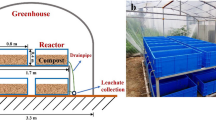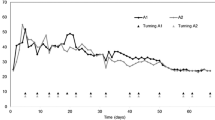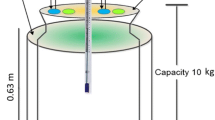Abstract
The compostability of starch–CaCO3 disposable packaging was examined in a source-separated municipal solid waste (MSW) composting facility located in East Hampton, NY. Source-separated MSW:starch–CaCO3 container mixtures of 0 (control), 5, and 20% (by volume) were prepared as feedstock for composting. Compost samples were collected weekly or biweekly during the composting process and examined for fragments of the starch–CaCO3 containers. Changes in compost quality due to the presence of starch–CaCO3 containers were assessed by measuring the nutrient and metal content of the three resultant MSW:starch–CaCO3 composts. Finally, plant growth studies were conducted to examine the composts for possible plant growth inhibition due to the deterioration of the starch–CaCO3 containers. Results showed that portions of the starch–CaCO3 containers were not identified in any of the 5 and 20% sieved and characterized compost fractions > 1.3 cm following 1–3 weeks of composting. Mechanical agitation of the waste along with optimum composting conditions were sufficient to initiate the rapid degradation of the starch–CaCO3 composites. Degradation of starch–CaCO3 containers did not affect compost nutrient and trace element content. Grass biomass measurements were performed once weekly over 28 days for grass grown in control (0%), 5%, and 20% starch–CaCO3-containing compost:soil mixtures. Significant differences in grass biomass for these compost:soil mixtures were measured only for the 0 and 20% starch–CaCO3-containing compost:soil mixtures at 28 days (9.07 vs 11.05 g, respectively; P = 0.046).
Similar content being viewed by others
REFERENCES
U. Pagga, D. B. Biemborn, and M. Yamamoto (1996). J. Environ. Polym. Degrad. 4(3), 173–178.
S. Bloembergen, J. David, D. Geyer, A. Gustafson, J. Snook, and R. Narayan (1994) in Y. Doi and K. Fukuda (Eds.), Proceedings of the Third International Scientific Workshop on Biodegradable Plastics and Polymers, Osaka, Japan, Nov. 9–11, 1993, pp. 601–609.
R. Narayan (1993) Polymers from Agricultural Coproducts, ACS Symposium Series 575, M. L. Fishman, R. B. Friedman, and S. Huang (Eds.), 206th National Meeting of the American Chemical Society, Aug. 22–27, 1993, Chicago, pp. 1–28.
N. Goldstein, R. Steuteville, and M. Farrell (1996) Biocycle Nov., 46–53.
CalRecovery, Inc. (1995) Production and Utilization of a Soil Additive from Aliite Foam Clamshell Material, Final Report No. 1401-3-1, CalRecovery, Inc., Hercules, CA, Mar.
L. R. Krupp and W. J. Jewell (1992) Environ. Sci. Technol. 26, 193–198.
J. D. Gu, S. Yang, R. Welton, D. Eberiel, S. P. McCarthy, and R. A. Gross (1994) J. Environ. Polym. Degrad. 2(2), 129–135.
V. T. Breslin and R. L. Swanson (1993) J. Air Waste Manage. Assoc. 43, 325–335.
E. Chiellini, F. Cioni, R. Solaro, G. Vallini, A. Corti, and A. Pera (1993) J. Environ. Polym. Degrad. 1(2), 167–170.
K. K. Leonas, M. A. Cole, and X. Y. Xiao (1994) J. Environ. Polym. Degrad. 2(4), 253–261.
P. Garnham (1995) Biocycle Nov., 53–57.
U.S. Environmental Protection Agency (1986) Test Methods for Evaluating Solid Waste, Office of Solid Waste and Emergency Response, U.S. Environmental Protection Agency, Field Manual SW-846.
M. Suffet and M. Stenstrom (1997) Executive Summary on Research Project for EarthShell Company, Santa Barbara, CA, University of California at Los Angeles. Environmental Science and Engineering Program, UCLA, Los Angeles.
P. B. Woodbury (1992) Biomass Bioenergy 3(3–4), 239–259.
C. Ciavatta, M. Govi, and P. Sequi (1993) Compost Sci. Utiliz. 1, 75–80.
T. Claussen (1990) Plant Soil 127, 91–95.
T. L. Richard (1992) Biomass Bioenergy 3(3–4), 163–180.
Federal Register (1993) 40 CFR 257, 403, and 503. 58(32), 9248–9415.
New York State Department of Environmental Conservation (NY DEC) (1993) 6 NYCRR Part 360 Regulations, Revisions/Enhancements to New York State's Solid Waste Management Facilities, Section 360-5.3, Operational Requirements: Sludge and Solid Waste, Class 1 Compost, Division of Solid Waste, Albany, NY.
A. Shiralipour, D. B. McConnell, and W. H. Smith (1992) Biomass Bioenergy 3(3–4), 261–266.
J. L. Cisar and G. H. Snyder (1992) HortScience 27(3), 219–222.
Author information
Authors and Affiliations
Rights and permissions
About this article
Cite this article
Breslin, V.T. Degradation of Starch–Calcium Carbonate Disposable Packaging in a Solid Waste Composting Facility. Journal of Polymers and the Environment 6, 9–21 (1998). https://doi.org/10.1023/A:1022822427764
Issue Date:
DOI: https://doi.org/10.1023/A:1022822427764




